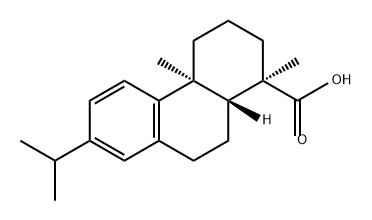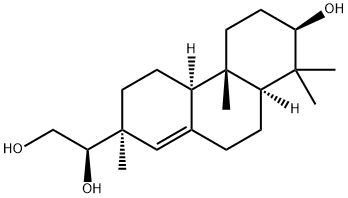Dehydroabietic acid
Synonym(s):Abieta-8,11,13-trien-18-oic acid;Dehydroabietate
- CAS NO.:1740-19-8
- Empirical Formula: C20H28O2
- Molecular Weight: 300.44
- MDL number: MFCD00045343
- EINECS: 217-102-8
- SAFETY DATA SHEET (SDS)
- Update Date: 2024-12-18 14:08:57

What is Dehydroabietic acid?
Chemical properties
White Solid or Colorless needle crystal, Slightly soluble in water, soluble in methanol, ethanol, DMSO and other organic solvents. It is an abietane diterpenic resin acid that is obtained from Pinus resin.
The Uses of Dehydroabietic acid
Dehydroabietic Acid is a resin acid found commonly in rosin. Dehydroabietic Acid is used in rosin-type nucleating agent for polypropylene (PP). Dehydroabietic Acid is used commonly in the synthesis of surfactants, antioxidants and chiral catalysts.
Definition
ChEBI: Dehydroabietic acid is an abietane diterpenoid that is abieta-8,11,13-triene substituted at position 18 by a carboxy group. It has a role as a metabolite and an allergen. It is an abietane diterpenoid, a monocarboxylic acid and a carbotricyclic compound. It derives from an abietic acid. It is a conjugate acid of a dehydroabietate.
What are the applications of Application
Dehydroabietic acid (DHA or DAA) is a bioactive phytochemical, diterpenoid found in various Pinus species. It is a resin acid and a derivative of abietic acid (AA).
Dehydroabietic acid has been used as a reference standard:
to study the aging process of Pinus resins using Fourier-transform infrared spectroscopy (FTIR)
to study the composition changes in Pinus genus with aging using Raman spectroscopy complemented with infrared spectroscopy
to estimate resistance against biotic stress as proxy in chemical defenses in Pinus halepensis
Biochem/physiol Actions
Dehydroabietic acid (DHA) exerts various biological activities such as anti-cancer, anti-aging, antimicrobial, antiulcer, gastroprotective, and cytotoxic activities. It is a potent anti-inflammatory agent and a dual activator of peroxisome proliferator-activated receptors alpha and gamma (PPAR α/γ). DHA has an anti-aging effect and a sirtuin 1 (SIRT1) activating compound. It has antibacterial properties against multidrug-resistant strains. dehydroabietic acid and its derivatives have gastroprotective and cytotoxic effects.
Properties of Dehydroabietic acid
| Melting point: | 174-176℃ |
| Boiling point: | 394.13°C (rough estimate) |
| Density | 1.058 |
| refractive index | 1.5404 (estimate) |
| storage temp. | Sealed in dry,Store in freezer, under -20°C |
| solubility | DMF: 30 mg/ml; DMSO: 30 mg/ml; Ethanol: 10 mg/ml |
| form | A solid |
| pka | 4.66±0.40(Predicted) |
| color | White to yellow |
| EPA Substance Registry System | Dehydroabietic acid (1740-19-8) |
Safety information for Dehydroabietic acid
| Signal word | Danger |
| Pictogram(s) |
 Skull and Crossbones Acute Toxicity GHS06  Environment GHS09 |
| GHS Hazard Statements |
H301:Acute toxicity,oral H410:Hazardous to the aquatic environment, long-term hazard |
| Precautionary Statement Codes |
P273:Avoid release to the environment. |
Computed Descriptors for Dehydroabietic acid
| InChIKey | NFWKVWVWBFBAOV-UHFFFAOYSA-N |
New Products
4-Fluorophenylacetic acid 4-Methylphenylacetic acid N-Boc-D-alaninol N-BOC-D/L-ALANINOL Tert-butyl bis(2-chloroethyl)carbamate 3-Morpholino-1-(4-nitrophenyl)-5,6-dihydropyridin- 2(1H)-one Furan-2,5-Dicarboxylic Acid Tropic acid S-2-CHLORO PROPIONIC ACID ETHYL ISOCYANOACETATE 2-Bromo-1,3-Bis(Dimethylamino)Trimethinium Hexafluorophosphate (6-METHYL-[1,3]DITHIOLO[4,5-b]QUINOXALIN-2-ONE INDAZOLE-3-CARBOXYLIC ACID 4-IODO BENZOIC ACID (2-Hydroxyphenyl)acetonitrile 4-Bromopyrazole 5,6-Dimethoxyindanone 2-(Cyanocyclohexyl)acetic acid 4-methoxy-3,5-dinitropyridine 2-aminopropyl benzoate hydrochloride 1-(4-(aminomethyl)benzyl)urea hydrochloride diethyl 2-(2-((tertbutoxycarbonyl)amino) ethyl)malonate tert-butyl 4- (ureidomethyl)benzylcarbamate Ethyl-2-chloro((4-methoxyphenyl)hydrazono)acetateRelated products of tetrahydrofuran








You may like
-
 Dehydroabietic acid CAS 1740-19-8View Details
Dehydroabietic acid CAS 1740-19-8View Details
1740-19-8 -
 Dehydroabietic acid CAS 1740-19-8View Details
Dehydroabietic acid CAS 1740-19-8View Details
1740-19-8 -
 1975-50-4 98%View Details
1975-50-4 98%View Details
1975-50-4 -
 2-HYDROXY BENZYL ALCOHOL 98%View Details
2-HYDROXY BENZYL ALCOHOL 98%View Details
90-01-7 -
 2-Chloro-1,3-Bis(Dimethylamino)Trimethinium Hexafluorophosphate 221615-75-4 98%View Details
2-Chloro-1,3-Bis(Dimethylamino)Trimethinium Hexafluorophosphate 221615-75-4 98%View Details
221615-75-4 -
 61397-56-6 CIS BROMO BENZOATE 98%View Details
61397-56-6 CIS BROMO BENZOATE 98%View Details
61397-56-6 -
 14714-50-2 (2-Hydroxyphenyl)acetonitrile 98+View Details
14714-50-2 (2-Hydroxyphenyl)acetonitrile 98+View Details
14714-50-2 -
 118753-70-1 98+View Details
118753-70-1 98+View Details
118753-70-1